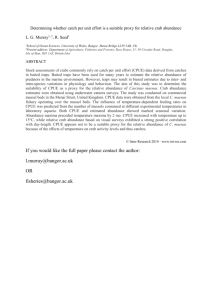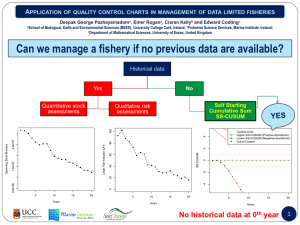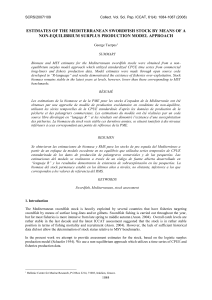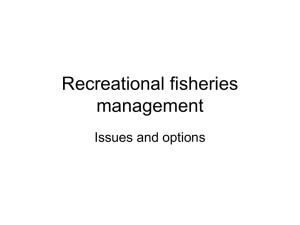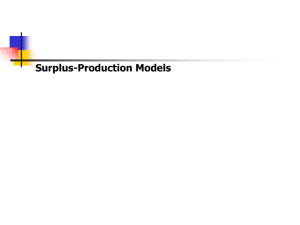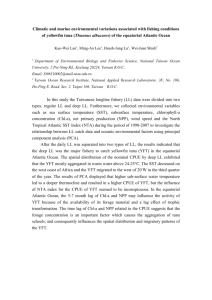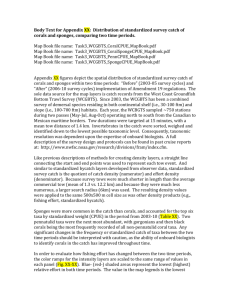K N rN dt dN ) 1(- = K rN rN
advertisement
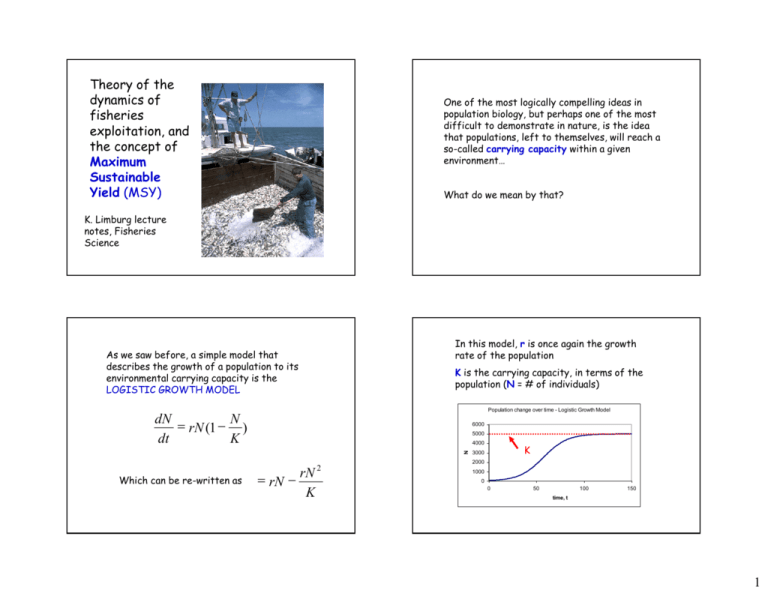
Theory of the dynamics of fisheries exploitation, and the concept of Maximum Sustainable Yield (MSY) One of the most logically compelling ideas in population biology, but perhaps one of the most difficult to demonstrate in nature, is the idea that populations, left to themselves, will reach a so-called carrying capacity within a given environment… What do we mean by that? K. Limburg lecture notes, Fisheries Science As we saw before, a simple model that describes the growth of a population to its environmental carrying capacity is the LOGISTIC GROWTH MODEL In this model, r is once again the growth rate of the population K is the carrying capacity, in terms of the population (N = # of individuals) Population change over time - Logistic Growth Model N dN rN (1 ) K dt 6000 5000 N 4000 Which can be re-written as rN 2 rN K K 3000 2000 1000 0 0 50 100 150 time, t 1 Population change over time - Logistic Growth Model r = 0.08 K = 5000 N0 = 50 6000 5000 4000 N The exact solution to this model (so that you can program this in Excel if you like) is 3000 2000 1000 0 0 50 100 150 time, t Population change over time - Logistic Growth Model 6000 5000 r = 0.08 K = 5000 N0 = 1000 N 4000 K Nt K N 0 rt 1[ ]e No 3000 2000 1000 0 0 50 100 150 time, t dB B rB (1 ) dt K Population change over time - Logistic Growth Model 12000 This might represent the dynamics of an unexploited fish stock… 10000 r = 0.1 K = 10000 N0 = 500 8000 N (Do this for extra credit – and remember what I said about order in which computations are made!) Just as we can track the changes in N over time, we can also keep track of the change in biomass (B), using the same model but substituting B for N: 6000 4000 2000 0 0 50 100 150 time, t To add exploitation onto this, we need another “loss term” to represent the harvest of biomass from the population. We’ll call it Y, to represent yield. dB B rB (1 ) dt K Y Theoretically, if a fishery is in steady state, such that the yield (Y) is in balance with the growth rate of the population, then Y rB(1 B ) K 2 Hypothetical fish population responds to harvest regimes If you can balance the harvest rate just at half of the carrying capacity, then you will be “cropping” the stock when it is growing the fastest (in theory!) harvest assume logistic population growth Biomass growth K K (King 1995) In this graph, carrying capacity (K) is called B …and MSY stands for Maximum Sustainable Yield Time Slide courtesy C.M. Mayer Biomass small harvests, slow growth near K keeps biomass oscillating around K/2, highest growth rate, leads to MSY The models used to derive MSY are a group called SURPLUS PRODUCTION MODELS And MSY itself is referred to as a “biological reference point” K This means that it is a management criterion that is derived from biological considerations K/2 Oops… Time Other considerations include economics, social welfare, etc. and can have other reference points 3 Y q f B, Thinking about MSY in terms of fishing effort… Recall that we can define harvesting in terms of fishing effort, i.e. Y q f B, Where q = the “catchability” coefficient f = fishing effort (Q: what are some possible units??) Note that Y/f is the catch per unit of effort, or CPUE. …is defined as the proportion of the total stock caught by 1 unit of effort – can vary due to a number of factors, so must be measured (or assumed). f, fishing effort, is the total amount of effort used and should always be standardized to a specific kind of effort (e.g., hours of fishing with a particular gear and vessel, horsepower, etc) Y f CPUE Y q f B Then B = CPUE/q . If we substitute CPUE/q into the equation of MSY, we get… B Y rB(1 ) K q, the catchability coefficient: Substitute CPUE/q in here for B… CPUE CPUE q r 1 q CPUE q Y rB (1 B ) K CPUE when B = K CPUE CPUE q 1 f CPUE r q CPUE q Divide through by CPUE… 4 q CPUE CPUE f CPUE r If we divide by CPUE and collect terms, we get CPUE = a - b f r CPUE f 1 q CPUE Multiplying by fishing effort, f, and recalling that Y = f x CPUE, we finally get SCHAEFER’S MODEL: Rearranging, it becomes q CPUE CPUE f CPUE r Y af bf 2 Once again, this is the equation of a straight line… q CPUE CPUE f CPUE r Y af bf 2 CPUE = a - b f Q: What’s so great about the Schaefer model? A: If we know f (the amount of fishing effort used in a fishery), and we know Y (the yields at different levels of f ), then we can estimate the parameters a and b. CPUE (= Y/f) a = y-intercept = CPUE CPUE q/r = -b (the slope) x-intercept = -a/b Fishing effort (f) (annihilation) 5 …we can solve for r. Once we know a and b, we can apply it to the equation for CPUE and get logistic growth parameters: Y af bf 2 CPUE = a - b f q CPUE CPUE f CPUE r a b Y Again, knowing this relationship allows us to estimate a and b… f If we know q, then we have an estimate of B (because CPUE/q = B), and then finally… Another thing that comes out of the Shaefer model is the level of effort corresponding to MSY (fMSY). This is found by differentiating the Shaefer model with respect to f and solving for fMSY. f MSY a 2b (often you’ll see “E” instead of “f” for effort) …and then, if we know (or assume a value for) q, we can solve for B, the biomass of the fish stock when it’s at carrying capacity. At least, in theory! f MSY a 2b It can be substituted into the Shaefer model equation to solve for MSY: MSY a ( a a a2 a2 a2 ) b( ) 2 2b 2b 2b 4b 4b Example: a = 10, b = -0.01. Then MSY = -100/(-0.04) = 2500 6 Fisheries biologists also note that this is a guide for knowing the level of effort that drives a fishery “over the cliff” – i.e., is overfished. This is defined as foverfished = 2 fMSY That is, a fish stock is overfished when f a b Extensions of the MSY model A number of variations on MSY modeling exist. Among them is a model by Fox (1970)* that uses an asymmetric effort curve, rather than the Schaefer symmetric parabola: Y ln(CPUE ) ln( ) a bf f * Fox, WW. 1970. Trans. American Fisheries Society 99: 80-88. Y ln(CPUE ) ln( ) a bf f The FAO (Food and Agricultural Organization of the United Nations) online manual of fisheries management (Sparre and Venema, 1998, Chapter 9) states: “…the choice between the two models becomes important only when relatively large values of f are reached. It cannot be proved that one of the two models is superior to the other. You may choose the one you believe is the most reasonable in each particular case or the one which gives the best fit to the data.” (my italics) 7 These surplus yield models are very attractive, because they don’t require nearly as much data as other models (no need to determine ages, or sizes of cohorts, no direct estimate of mortality, etc.) However, as we’ll see later, these models have caused a lot of grief to world fisheries. Hence, it is likely to be adopted in situations where data are scarce. (Q: is this a good thing?) Photo: Candace Feit, The New York Times Maximum Sustainable Yield: National and International Definitions 1) The largest long-term average catch or yield that can be taken from a stock or stock complex under prevailing ecological and environmental conditions. (US National Marine Fisheries Services (NOAA Fisheries) strategic plan. Glossary of terms. http://www.nmfs.noaa.gov/om2/glossary.html) 2) Maximum use that a renewable resource can sustain without impairing its renewability through natural growth or replenishment. (United Nations. Glossary of environmental statistics. http://unstats.un.org/unsd/environmentgl/ ) Literature cited. King, M. 1995. Fisheries Biology, Assessment and Management. Fishing News Books (Blackwell). Sparre, P., and Venema, S.C. 1998. Introduction to tropical fish stock assessment. Part 1. Manual. FAO Fisheries Technical Paper. No. 306.1, Rev. 2. Rome, FAO. 407p. (available online) 8

